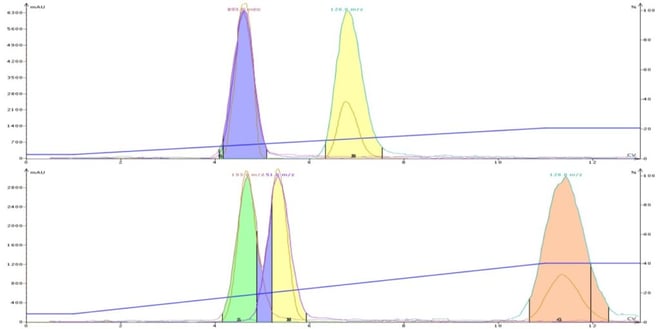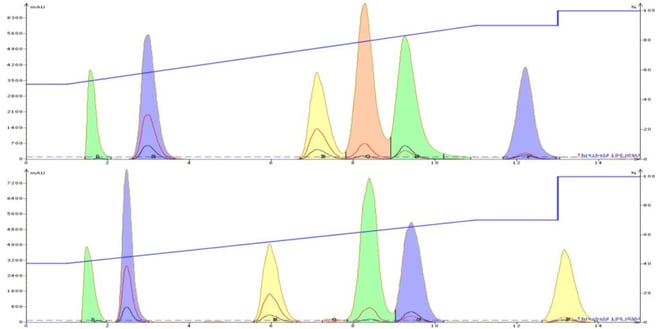Selectivity and solvent strength are the most important factors that determine success or failure of a chromatographic separation. These two independent dynamics apply to both normal- and reversed-phase chromatography and should be optimized, especially when high fraction purity is needed.
In this post I will discuss the impact that elution solvent choice has on both normal- and reversed-phase purification.
To isolate compounds with high purity the elution solvent strength should be optimized to bring your targeted product into the ideal separation zone. By TLC this means adjusting the solvent strength so that your targeted compound has an Rf between 0.1 and 0.4. When evaluating various solvent blends for selectivity, optimization it is beneficial to compare TLC data with solvent mixtures that provide similar elution strength.
Solvent strength equalization helps to ensure that the separation data can be rationally compared over a similar time or volume. In normal-phase this is helpful when screening solvents and developing methods with TLC. Each solvent has a different strength relative to the sorbent used, either silica or alumina, so the solvent ratio for any solvent pair will be different in order to obtain similar compound retention for your targeted molecule. In a previous post I discussed this in regards to substituting acetonitrile for methanol in normal-phase purifications using DCM as the weak solvent.
Methanol and acetonitrile have different solvent strengths and fall into different selectivity classes as well, Table 1. If you replace methanol with acetonitrile for the same sample purification, then a different solvent ratio is required to get the targeted compound to elute in about the same solvent volume.
| Solvent | Selectivity |
| Acetone | VI |
| Acetonitrile | VI |
| Cyclohexane | 0 |
| Dichloromethane | V |
| Ethanol | II |
| Ethyl acetate | VI |
| Ethyl ether | I |
| Heptane | 0 |
| Hexane | 0 |
| Isopropanol | II |
| Methanol | II |
| Tetrahydrofuran | III |
| Toluene | VII |
| Water | VIII |
Table 1. Solvent selectivity
What I found interesting was that although my TLC runs provided identical Rf values for the last eluting compound in the sample mix the flash chromatography based on the TLC data provided different results. The DCM/MeOH gradient co-eluted the first two compounds while the DCM/MeCN gradient retained the compounds more and actually separated the two early eluting compounds, Figure 1.As an example, I evaluated DCM/MeOH and DCM/MeCN blends by TLC for the purification of a 3-compound mixture. To ensure the target would elute in a similar amount of solvent by TLC, I evaluated some solvent blends and found that 20% acetonitrile in DCM was equivalent to 10% methanol in DCM (provided the same Rf for my targeted compound, 0.34). The other two compounds eluted faster with minimal separation.
The retention and selectivity difference is due to the highly protic nature of the methanol. DCM/MeOH based TLC data often does not translate directly to flash as other solvent mixtures do. The separation improvement with acetonitrile is due to both the different selectivity class and the fact that it is aprotic.
 Figure 1. Comparison of a DCM/MeOH separation (top) and DCM/MeCN separation at equal solvent strength. The data shows a separation improvement with acetonitrile.
Figure 1. Comparison of a DCM/MeOH separation (top) and DCM/MeCN separation at equal solvent strength. The data shows a separation improvement with acetonitrile.
Methanol and acetonitrile just happen to be the two most commonly utilized strong solvents in reversed-phase chromatography as well. In reversed-phase, as with normal-phase, the strong solvent influences compound retention. In reversed-phase though, the strong solvent also exclusively impacts selectivity as the weak solvent (water) has no selectivity impact much like hexane/heptane/etc have no selectivity impact in normal-phase.
In reversed-phase methanol is more polar, and therefore weaker, than acetonitrile so more methanol is needed to elute the same sample components[1]. The amounts of methanol and acetonitrile required to provide similar compound retention on a reversed-phase column are seen in Table 2.
| Solvent | Strength |
| Acetone | 0.50 |
| Acetonitrile | 0.51 |
| Cyclohexane | 0.04 |
| Dichloromethane | 0.32 |
| Ethanol | 0.65 |
| Ethyl acetate | 0.43 |
| Ethyl ether | 0.40 |
| Heptane | 0.01 |
| Hexane | 0.01 |
| Isopropanol | 0.60 |
| Methanol | 0.71 |
| Tetrahydrofuran | 0.53 |
| Toluene | 0.24 |
| Water | 1.00 |
Table 2. Equal solvent strength
Selectivity differences may be observed in reversed-phase as well when the strong solvent is changed so be aware that there may be some variation in the separation. In Figure 2, this selectivity difference is clearly visible with the third eluting peak (yellow) being better resolved from the other peaks in a water/acetonitrile gradient.
 Figure 2. Comparison of a water/MeOH gradient (top) and a water/MeCN gradient at similar solvent strength in the reversed-phase separation of a 5-compound mix. Acetonitrile provides different selectivity, especially for the second and third eluting peaks.
Figure 2. Comparison of a water/MeOH gradient (top) and a water/MeCN gradient at similar solvent strength in the reversed-phase separation of a 5-compound mix. Acetonitrile provides different selectivity, especially for the second and third eluting peaks.
So, to get the best flash purification results evaluate various strong solvents and solvent ratios with miscible weak solvents during method development. You may be pleasantly surprised with the results.
If you would like to learn more about flash chromatography, please download our whitepaper Successful Flash Chromatography.
[1] www.sander-kok.com

 Organic Workflow
Organic Workflow Peptide Workflow
Peptide Workflow Scale-Up Flash Purification
Scale-Up Flash Purification  Sample Preparation
Sample Preparation Biomolecule Purification
Biomolecule Purification Oligo synthesis
Oligo synthesis Scavengers and Reagents
Scavengers and Reagents Service & Support
Service & Support Accessories & Spare parts
Accessories & Spare parts Investors
Investors Reports & News
Reports & News The Share
The Share Corporate Governance
Corporate Governance Calendar
Calendar Sustainability
Sustainability Our Offering
Our Offering Our History
Our History Our Locations
Our Locations Leadership
Leadership